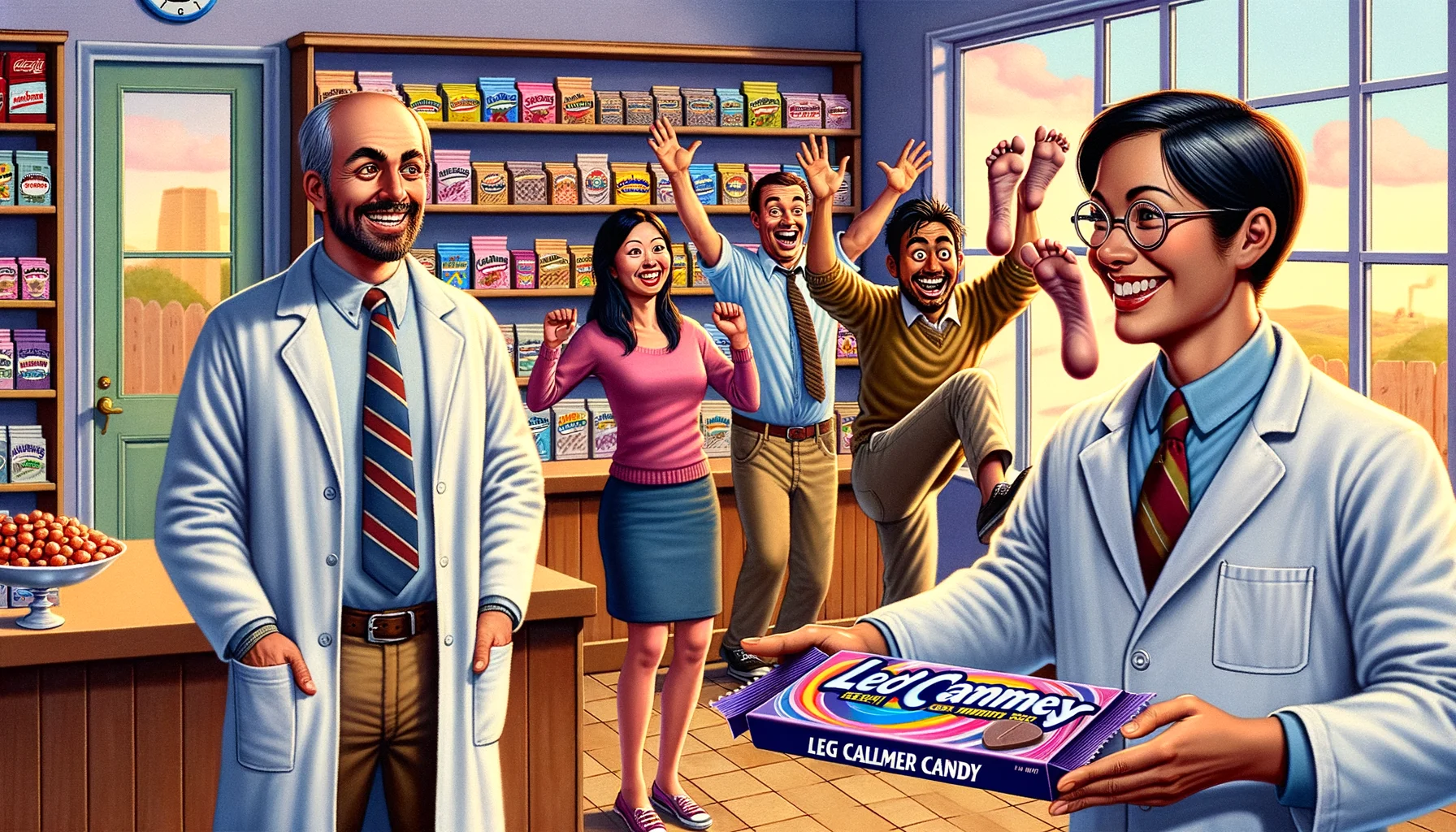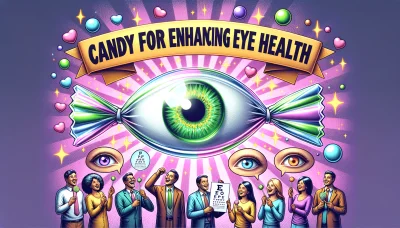Candy for Managing Restless Leg Syndrome Quiz
Test Your Knowledge
Question of
Understanding Restless Leg Syndrome
Symptoms and Diagnosis
Identifying Common Symptoms
Have you ever felt like there were ants marching up and down your legs as you lay in bed, desperately craving the sweet embrace of sleep? That's a little taste of what Restless Leg Syndrome (RLS) can feel like. It's a condition that often manifests as an irresistible urge to move one's legs, typically accompanied by uncomfortable sensations. These feelings have been whimsically described as 'pop rocks under the skin' or 'internal itchiness that no amount of scratching can soothe.' They usually occur during periods of inactivity, making relaxation and sleep elusive treasures.
People with RLS might describe their nightly ordeal as a tragicomedy, where their legs take on the role of mischievous sprites, frolicking and capering about when all they want is peace. The symptoms can range from mildly irritating to downright debilitating. It's like having a restless confectionery factory in your limbs, producing batches of tingles and twitches instead of candy.
The Process of Getting Diagnosed
The journey to diagnosis often begins with recounting these peculiar sensations to a healthcare provider. It's like trying to explain the flavor of a mysterious new candy it might not fit into the conventional categories of sweet, sour, or bitter. Doctors will listen to your story, consider your medical history, and rule out other potential causes for your symptoms. Sometimes they might look at you as if you've claimed to see unicorns frolicking in your garden, but rest assured, they're just sifting through their medical knowledge for answers.
There isn't a specific test for RLS; it's more like a taste test where doctors use their expertise to discern the subtle notes and undertones of your condition. They'll likely ask about the frequency and severity of your symptoms, perhaps even delving into family history after all, RLS can be quite the hereditary treat.
Importance of Professional Medical Advice
While it might be tempting to self-diagnose based on a few internet articles or anecdotes from friends who swear by certain remedies like chocolate-covered cherries for everything from heartache to hair loss, professional medical advice is key. Think of it this way: you wouldn't trust an amateur baker to create a wedding cake masterpiece; similarly, navigating the complexities of RLS requires expert guidance.
Consulting with a healthcare provider ensures that you receive personalized advice tailored to your unique needs something that no generic internet article could ever provide (no matter how many delicious metaphors it uses).
Causes and Triggers
Genetic Factors
Much like inheriting a sweet tooth from your parents, RLS can be passed down through generations. If your relatives have experienced this syndrome, you may find yourself more likely to encounter these jittery leg sensations yourself. Its not exactly the family heirloom one dreams about unlike grandmas secret fudge recipe.
Scientists are still unwrapping the genetic mysteries behind RLS like a tricky piece of candy foil. However, they have identified certain genetic markers associated with the condition that contribute to its development.
Lifestyle and Environmental Triggers
- Caffeine: Like too much sugar in a dessert can overpower its flavors, excessive caffeine consumption can exacerbate RLS symptoms.
- Alcohol: A nightcap might seem soothing but think of alcohol as the sneaky ingredient that throws off an entire recipe it can trigger RLS episodes.
- Sleep Habits: Poor sleep hygiene is akin to storing chocolate in sunlight; it just makes everything worse. Good sleep practices are crucial for managing RLS.
Underlying Health Conditions
Occasionally, RLS is like an unwanted side dish served alongside other health conditions such as iron deficiency or neuropathy. Its important not just to focus on the main course but also pay attention to whats on the side.
Addressing these underlying issues may sometimes alleviate RLS symptoms think about fortifying your body with essential nutrients rather than reaching for quick-fix sugary snacks.
Current Treatments and Therapies
Medication Options
Sometimes managing RLS requires more than just lifestyle changes; it calls for medication not unlike those times when only the most decadent chocolate truffle will do. There are medications designed specifically for RLS that work by balancing dopamine levels in the brain or affecting calcium channels think of them as carefully measured ingredients needed to perfect a complex confection.
While medication can be effective, remember that everyone's biochemistry is unique; what works for one person might not work for another. It's similar to taste preferences some people swoon over licorice while others recoil at its mere mention.
Physical Therapy and Exercises
Moving those restless legs might seem counterintuitive when they're already dancing against your will every night. Yet physical therapy and exercises are often recommended as part of an RLS treatment plan. Consider them structured dance lessons for your limbs, teaching them how to move rhythmically rather than chaotically.
Gentle stretching before bedtime could be compared to kneading dough preparing it for perfect consistency before it rests. Regular exercise is also beneficial; think about it as mixing various ingredients together to create balance within your body.
Alternative Remedies
In addition to conventional treatments, some find relief in alternative remedies such as acupuncture or massage therapy - akin to exploring exotic flavors beyond your usual candy repertoire.
Mindfulness meditation could also help calm both mind and restless legs alike imagine focusing on breathing and relaxation techniques as savoring each bite of a luxurious chocolate slowly melting on your tongue.
The Role of Diet in Managing RLS
Nutritional Considerations for RLS
When I first heard that what I ate could influence my restless legs, I was both skeptical and hopeful. Could a few dietary tweaks really calm the relentless dance beneath my skin each night? As I delved into the world of nutrition, I discovered that certain vitamins and minerals were like a quiet lullaby to my jittery limbs. It's been a journey of trial and error, but let me tell you, when you hit the right notes, the symphony is sweet.
And it's not just about what you add to your diet; it's equally about what you subtract. There are sneaky culprits lurking in our pantries that can wake the sleeping dragon of RLS. Identifying these has been like playing detective in my own kitchen a culinary mystery with a very personal stake.
Essential Vitamins and Minerals
The whispers among fellow RLS sufferers pointed me towards iron and magnesium two minerals that have become my nightly guardians. When they're around, my legs are more inclined to rest. But they're not lone heroes; they come with a band of allies potassium, vitamin D, and B vitamins each playing their part in this delicate dance of chemistry and comfort.
Foods to Avoid
Now, let's talk about those foods that seem to have it out for our peaceful evenings. Caffeine, alcohol, and refined sugars aren't just party poopers; they're like an alarm clock for my legs. Steering clear of them as evening approaches has been a game-changer. My nighttime routine has transformed from a restless ritual into a restful retreat.
Hydration and Its Effects
Hydration also plays its part in this intricate ballet. Who knew that water could be such a powerful conductor for calm? Ensuring I'm well-hydrated throughout the day seems to keep the twitching at bay come nightfall. It's like each sip is a gentle wave soothing the shores of my nervous system.
The Impact of Sugar on RLS
Oh, sugar that sweet seductress! We've all succumbed to her charms only to later curse her name as our legs prance about when we're trying to sleep. The link between sugar intake and RLS symptoms is like a bitter romance; too much sweetness can lead to an unhappy ending when the lights go out.
Blood Sugar Levels and Symptoms
I've noticed that when my blood sugar levels swing faster than a pendulum at a dance party, so do my legs. Keeping those levels steady is like finding the perfect tempo not too fast, not too slow just right for keeping things smooth and steady.
Natural vs. Processed Sugars
- Natural Sugars: Found in fruits and honey, they're like nature's candy sweet yet innocent enough not to ruffle too many feathers.
- Processed Sugars: The mischievous twins often hidden in processed foods these are the ones that throw wild parties in your bloodstream.
Moderation and Balance in Consumption
Balancing sugar consumption has been less about strict rules and more about harmony. A little indulgence here and there won't cause chaos, but understanding moderation has been key. It's like being the maestro of your own internal orchestra; too much of any instrument can disturb the harmony.
Beneficial Foods for RLS Relief
Discovering foods that soothe RLS has been akin to finding hidden treasures within the vast culinary landscape. These edibles aren't just nourishing; they hold secret powers to quell the inner turmoil of restless legs.
Anti-inflammatory Foods
Foods with anti-inflammatory properties have become my allies in this ongoing battle against RLS discomfort. They work covertly through meals to dial down inflammation, offering respite from within. It feels almost magical when something as simple as an omega-rich fish or vibrant berries can cast such calming spells on agitated limbs.
Foods Rich in Iron and Magnesium
The duo of iron and magnesium continues to be celebrated on my plate daily. They don't demand attention; rather, they silently bolster my defense against the night-time enemy of restlessness. Their presence is felt most profoundly when absent their deficiency leaving a noticeable void where tranquility once lay.
Candy as a Comforting Solution for RLS
Who would have thought that the rustle of a candy wrapper could be like a symphony to the ears, a prelude to the sweet relief from the incessant twitching and wriggling of restless legs? There's something almost magical about finding solace in the sweetness of candy when my legs decide to dance without my permission. The idea that certain candies could offer more than just a momentary pleasure, but also a bit of respite from Restless Leg Syndrome (RLS), is both intriguing and a welcome excuse to indulge.
It's not just about giving in to cravings; it's about nurturing ourselves with little acts of kindness. And sometimes, that kindness comes wrapped in foil or nestled within the crinkles of a candy bag. But as I've learned, not all treats are created equal when it comes to managing RLS symptoms. Let's unwrap this topic together, shall we?
Types of Candy Beneficial for RLS
Candies with Essential Nutrients
In my quest to appease both my sweet tooth and my fidgety limbs, I've stumbled upon candies that are enriched with essential nutrients. Magnesium-rich chocolate has been a delightful discovery, its creamy texture melting on my tongue while delivering a mineral acclaimed for its muscle-relaxing properties. Now, don't get me wrong, I'm not advocating for an all-chocolate diet (tempting as that may be), but in moderation, it feels like I'm casting a delicious spell for tranquility upon my legs.
Then there are those zesty lemon drops infused with vitamin C and iron two nutrients that play supporting roles in our body's overall health. Who knew that these tangy morsels were more than just a pucker-worthy pleasure? It's like turning your medicine cabinet into a candy store where wellness meets whimsy on your taste buds.
Low-Sugar Candy Options
But let's face it, too much sugar can turn the body into a rollercoaster of highs and lows not exactly what you want when you're already dealing with jittery legs. That's why low-sugar candy options have become my covert allies in managing RLS. They're like undercover agents working quietly to satisfy cravings without causing havoc on blood sugar levels.
Sugar-free hard candies and gummies are now regulars in my snack drawer their vibrant flavors tricking my palate into thinking it's indulged while keeping things steady-eddy inside. It's about striking that sweet balance: savoring life's sugary moments without going overboard.
Organic and Natural Candies
- The simplicity of organic fruit snacks: These little gems remind me that sometimes less is more. No artificial this-and-that just straightforward goodness.
- All-natural licorice: A throwback to simpler times when treats were made with ingredients you could actually pronounce.
- Honey sticks: Natures own sweetener encased in straw-like tubes pure joy in liquid form.
Timing and Quantity of Candy Intake
Best Times to Consume Candy for RLS
I've found that timing can be everything when it comes to treating myself to candy for RLS relief. Theres an art to knowing when your body might benefit most from these confectionery companions. A piece of dark chocolate in the evening seems almost therapeutic, easing into the night with a serene ritual before the leg-tapping symphony begins.
Mornings, however? Not so much. Starting the day with sweets might give me an initial burst of energy, but its short-lived and could potentially agitate symptoms. Its all about listening to your body's rhythm and finding those sweet spots throughout the day when a candy break can bring comfort without consequences.
Recommended Serving Sizes
Serving sizes can be laughably small when you're looking at them through the lens of desire who eats just two squares of chocolate or five gummy bears? But I've learned discipline through necessity; too much indulgence can lead to guilt bigger than any candy bar. Moderation is key; it turns each bite into something savored, something special.
A treat becomes truly treasured when its enjoyed mindfully respecting both its powers of pleasure and its potential pitfalls if overdone. Its about honoring your bodys needs while still dancing on the edge of decadence.
Understanding the Glycemic Index
Choosing the Right Candy for RLS Management
Ingredients to Look For in Candy
When my legs start their nightly dance beneath the sheets, I know it's time for a little sweet intervention. I've learned that not all candies are created equal, especially when managing Restless Leg Syndrome (RLS). It's like embarking on a treasure hunt where the gold is finding the right ingredients that might just help soothe my jittery limbs.
There's a certain charm in unwrapping a piece of candy, the anticipation of flavor and relief mingling like an old melody. But before indulging, I've become quite the detective, peering at labels and seeking out natural ingredients over artificial additives. It's like choosing between a hand-knitted sweater from grandma or a polyester blend from the bargain bin one just feels inherently better.
And then there's the quest for those elusive key vitamins and minerals . Magnesium often takes center stage, with whispers in every RLS forum suggesting its gentle calm on unruly muscles. The pursuit doesn't end there; iron and folic acid also join the chorus, hinting at their part in this nocturnal ballet.
- Natural Ingredients vs. Artificial Additives
- Key Vitamins and Minerals in Ingredients
- Allergen-Free Options for Sensitive Individuals
Texture and Formulation Considerations
The texture of candy is more than just a matter of preference; it's a sensory experience that can play into how we manage RLS. There are nights when I crave the prolonged satisfaction of sucking on a hard candy , letting it slowly dissolve as if coaxing my legs to unwind along with it. The longevity of flavor becomes an unexpected ally against the restlessness.
But let's not overlook our chewy comrades. Chewy options offer their own form of therapy an almost meditative rhythm as teeth work through the resistance, providing a subtle distraction from the incessant urge to move. Yet, I sometimes wonder if hard candies might hold an advantage with their lingering presence, extending their soothing powers.
The role of flavor cannot be overstated either. It turns out that taste buds can be quite persuasive in convincing our brains to focus on pleasure over discomfort. Who would have thought that a burst of lemon or a whisper of mint could act as a diversion tactic against the creeping sensations?
Reading Labels and Understanding Claims
I've become quite adept at reading labels squinting at tiny fonts as if they hold the secrets to life itself (or at least a peaceful night). Deciphering nutritional information has become second nature; I'm on a first-name basis with terms like 'servings per container' and 'daily value percentage'. It's about understanding what goes into my body and how it might affect my restless companions down below.
Misleading marketing terms often lurk around corners like jesters at court, ready to trick with words like 'natural flavors' and 'clinically tested'. They're akin to mirages in the desert hopeful illusions that vanish upon closer inspection. Identifying these terms has become part of my nightly ritual, ensuring I'm not swayed by sweet nothings whispered by cunning marketers.
Certified labels have become beacons of hope stamps of approval that promise some level of scrutiny has been applied. Like seals on ancient scrolls, they offer assurance that what I'm about to consume has been deemed worthy by some higher authority. Recognizing these certifications amidst a sea of claims is like finding a friend in a crowded room comforting and reassuring.
Lifestyle Tips to Enhance the Benefits of Candy for RLS
Pairing Candy with Healthy Habits
As someone who has tiptoed around the restless leg syndrome (RLS) dance floor, I've found that sometimes, the sweet melody of candy can be a surprising partner in my routine. But hold on, before you raise an eyebrow, let me share how I balance this indulgence with healthy habits. It's like adding a dash of cinnamon to your hot chocolate; it complements the experience.
Imagine this: after a long day, you're sitting back, legs eager to jitter away, and there you are, unwrapping a piece of candy. The scent of sugary bliss fills the air, and as you savor that first bite, your taste buds tango in delight. But there's more to this dance than just the treat; it's about pairing that moment with habits that support your well-being.
Exercise Routines to Complement Dietary Choices
They say laughter is the best medicine, but have you tried exercise for RLS? It's like trying to pat your head and rub your belly at the same time tricky at first but surprisingly effective once you get the hang of it. A daily stroll or some gentle yoga can work wonders for those twitchy legs. And when paired with that occasional candy treat? It's like finding out your grandma is secretly a salsa champion unexpected but absolutely fantastic.
Sometimes I imagine my RLS as this over-enthusiastic dance partner. To keep up, I've incorporated stretches and low-impact exercises into my routine. Its not about running marathons; its about finding that sweet spot where movement meets comfort. And after working up a little sweat, a small piece of candy feels like a well-deserved encore.
Sleep Hygiene Practices for Better Rest
- Create a Sleep-Inducing Bedroom: An oasis of calm with dim lights and perhaps a hint of lavender.
- Establish a Regular Sleeping Pattern: Even on weekends! (Yes, I hear your collective groans.)
- Limit Screen Time Before Bed: Because scrolling through memes at midnight is not the lullaby our brains need.
Mindfulness and Relaxation Techniques
Mindfulness is like giving your mind its own cozy blanket and telling it to chill for a while. Meditating before bed or practicing deep-breathing exercises can make those restless legs feel like they've just had a soothing spa day. And when coupled with the occasional candy treat? It's like sneaking dessert before dinner rebelliously relaxing.
I often find myself doing guided visualizations where my legs are as still as ancient redwoods powerful stuff. Add in some progressive muscle relaxation techniques and voil! You might just trick those legs into tranquility for long enough to enjoy that piece of candy in peace.
Avoiding Potential RLS Aggravators
We all have that one friend who means well but somehow always steps on our toes during a friendly dance-off. Similarly, certain lifestyle choices can exacerbate RLS symptoms faster than you can say "sugar rush." So while we navigate through our daily routines (and occasional treats), it's important to sidestep these potential aggravators with grace.
Common Lifestyle Factors That Worsen Symptoms
We know caffeine can turn our legs into uncontrollable tap dancers, so moderating that coffee intake is key think decaf or half-caf instead of espresso shots at midnight. Alcohol is another culprit; while it might seem like liquid courage for our taste buds, it can lead our legs astray in the night. And then there are those sneaky refined sugars yes, even in candy which should be enjoyed mindfully.
The Importance of Regular Health Check-ups
A check-up is not just about stepping on scales and getting poked with needles; it's an opportunity to fine-tune our bodies like instruments in an orchestra. Regular visits to healthcare professionals help ensure we aren't unknowingly conducting an RLS symphony with our daily choices.
Stress Management Strategies
If stress were a flavor, it'd be sour lemon no sugar coating here. Managing stress through activities such as journaling or engaging in hobbies helps keep those leg twitches at bay. It's about finding activities that act as stress-busters rather than stress-boosters think painting or knitting over doom-scrolling on social media!
Integrating Candy into a Balanced Diet
Now don't get me wrong; I'm not advocating turning your pantry into Willy Wonkas factory (tempting though that may be). However, integrating candy into ones diet can be akin to adding sprinkles atop a well-balanced nutritional sundae sparingly but joyfully used.
Crafting a Personalized Meal Plan
Your diet is like your personal playlist everyone has different tastes and needs. Including diverse food groups ensures you dont miss out on any vital nutrients while still leaving room for life's little pleasures (hello there, dark chocolate square).
The Role of Portion Control
I've learned portion control is key; think fun-sized bars instead of king-sized feasts. Enjoying candy should feel like receiving an encore at the end of an amazing concert - special and not overdone.
Combining Treats with Nutrient-Dense Foods
A balanced diet isn't monochrome; its bursting with colors from fruits and veggies, grains and proteins - each adding their unique brushstroke to the canvas of our health. When we add treats into this mix responsibly, it's like the perfect cherry on top - small yet satisfying.
In conclusion, managing RLS doesn't mean denying yourself all lifes sweetnesses - its about harmonizing them within the melody of healthy living. So go ahead - unwrap that candy slowly, let its flavors bloom on your tongue as you remember: this isn't just about savoring sugar; it's about savoring life itself.
Real-Life Success Stories and Testimonials
Personal Accounts of Managing RLS with Candy
Once upon a time, nestled within the pages of an online forum, I stumbled upon a thread that twinkled with the unexpected joy of candy. Here, individuals shared their whimsical tales of how these sugary treats had become allies in their quest to soothe the relentless dance of Restless Leg Syndrome (RLS). With each testimonial, I found myself both amused and intrigued by the notion that something as simple as candy could bring comfort to those engaged in this nightly tango.
The stories were as varied as the candies themselves; some spoke of the lulling effect of peppermint's cool embrace, while others recounted the gentle caress that chocolate's richness bestowed upon their jittery limbs. It wasn't just about indulgenceit was about finding solace in flavor, texture, and the ritual of unwrapping a piece of candy, allowing its sweetness to unfold slowly on the tongue as if it could coax the restlessness from their muscles.
Individual Experiences with Different Types of Candy
In my virtual travels, I encountered Jenny who swore by her nightly ritual involving licorice twists. She described how their chewy texture provided a peculiar kind of distraction, a sensory detour that somehow quieted her restless legs. Then there was Michael, whose penchant for sour gummies seemed to counteract his symptoms with their puckering puncha zesty tango that somehow lulled his legs into stillness.
Duration and Consistency of Candy Consumption
Ralph, a grizzled veteran in coping with RLS, detailed his methodical approach: two pieces of hard candyone at dusk and another before bedhad become his cadence for calm. His commitment spanned months, and he spoke not only of managing his symptoms but also savoring this sweet spot in his evening routine.
Changes in Symptoms Over Time
Miriam's account was particularly poignant; she described how her initial skepticism gave way to cautious optimism as she noticed a gradual ebb in her nightly discomfort. With each passing week, her reliance on cherry-flavored chews became less about battling RLS and more about celebrating small victories over it.
Expert Opinions on Candy for RLS Relief
Insights from Nutritionists and Dietitians
I remember poring over blogs penned by nutritionists who discussed the potential role candy might play in managing RLS symptoms. They spoke not only of sugar's immediate gratification but also its possible effects on neurotransmittersthose tiny heralds within our bodies that carry messages of either turmoil or tranquility.
- Nutritionist A: Advocated for mindful indulgence, suggesting that occasional sweets could offer psychological comfort without derailing overall health.
- Dietitian B: Warned against excessive sugar intake but acknowledged anecdotal evidence where small amounts appeared beneficial for some individuals with RLS.
- Nutritionist C: Encouraged exploring natural sugars found in fruits as an alternative to processed candies.
Medical Professionals' Perspectives on Diet and RLS
I chuckled when I read Dr. Smith's article likening RLS to an uninvited dance partnerone who refused to leave when the music stopped. He didn't dismiss the candy anecdotes outright; instead, he urged readers to view these sweet interludes within the broader context of diet and lifestyle choices affecting RLS.
Then there was Dr. Lee, whose clinical tone softened as she recounted patient stories where strategic nibbles of chocolate seemed to serve as calming preludes to sleep. She was quick to clarify that these narratives did not constitute medical advice but rather highlighted the uniqueness of each individual's journey with RLS.
Research Findings on Sugar Intake and RLS
The research papers were dense forests to navigatesprinkled with terms like "dopamine" and "insulin." But amidst these scientific thicket lay nuggets of compelling data suggesting correlations between sugar consumption and symptom management for some people grappling with RLS.
I found myself immersed in studies hinting at sugar's double-edged swordits capacity to both trigger and alleviate symptoms under different circumstances. The evidence was far from conclusive yet tantalizing enough to spark conversations among those seeking respite from their nocturnal nemesis.
Community Support and Resources
Finding Support Groups and Forums
The camaraderie found within support groups was heartwarminga confectionery collective where strangers became confidants united by their shared experiences with RLS. In these digital gathering spaces, empathy flowed like honey, sweetening the often-bitter reality of chronic conditions.
I joined several forums myselfnot because I needed them for my legs but because there was something profoundly human about connecting with others over something as quirky as candy being a balm for restlessness.
Sharing Recipes and Tips for Healthy Treats
In one corner of the internet, I discovered a treasure trove: recipes for homemade candies infused with ingredients purported to be friendly toward restless legs. There were spirited discussions about which dark chocolates had just enough magnesium or which fruity concoctions provided antioxidant benefits without spiking blood sugar levels too high.
- "Ginger Snaps for Snappy Legs" : A recipe shared by someone who believed ginger could help calm their jittery joints.
- "Lavender Lollipops" : Created by an enthusiast convinced that lavender's soothing properties extended beyond aroma into taste.
- "Honeyed Hazelnut Bites" : Concocted by a user who joked they were stocking up for winter hibernation away from RLS flare-ups.









